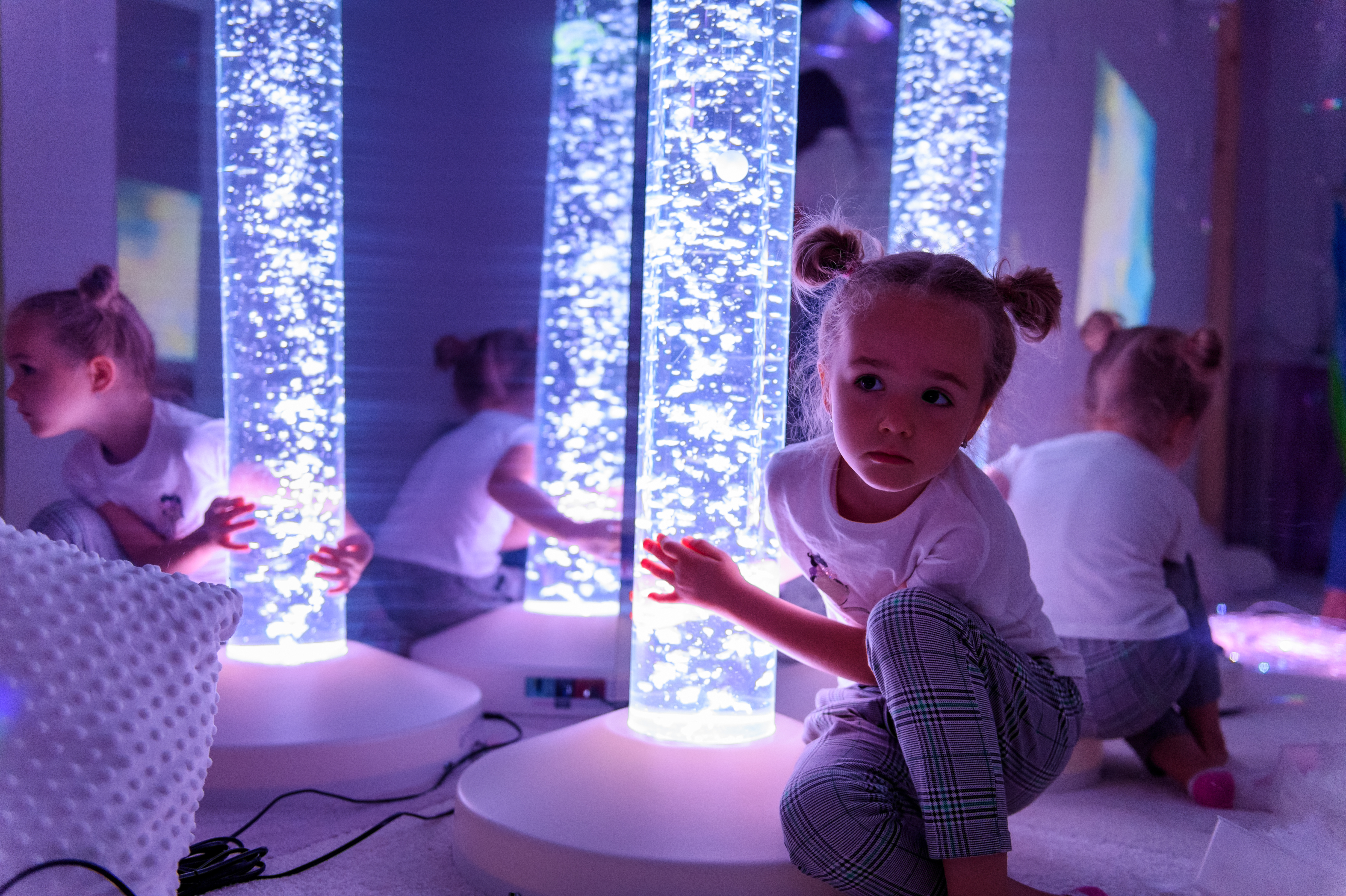By Amy Inman
What is a sensory room?
A sensory room provides a location for someone to calm their senses and escape environmental stimulation. As mentioned in the previous article, Sensory Overload and Autism, “Sensory overload occurs when one or more of an individual’s five senses receives too much stimulation from the environment. This event can cause a person’s brain to have difficulty processing the environmental input. When this issue happens, the body reacts by attempting to escape the sensory stimulation.” This is where a sensory room may be helpful as it can promote de-escalation from over-stimulation by providing a location that removes many sensory triggers such as bright lights or loud sounds. In addition, it can assist in crisis management when problem behaviors escalate to unmanageable levels by allowing the individual to self-regulate emotions and providing a safe place to express anger and frustration.

What is in a sensory room?
A sensory room typically utilizes dim lights, soft textures, dampened sounds, muted colors, and comfortable furniture to help the individual achieve a sense of calmness. In addition, these rooms offer items or activities that can help an individual calm down, relax, or decompress, especially after a stressful or emotionally charged episode. The items included in a sensory room are usually items or activities that the individual prefers or that can assist with de-escalation. Here are some examples of items that may be found in a sensory room:
- Swing (provides a rocking motion)
- Tent (provides a small and dim hiding spot)
- Yoga ball (provides a bouncing motion)
- Music (provides relaxation or distraction)
- Squishy or squeeze toys (provides soft textures)
- Trampoline (provides a bouncing motion)
- Noise-canceling headphones (provides the ability to block environmental sounds)
- Books (provides distraction)
As you can see, almost any item can be placed in a sensory room to help the individual gain coping skills and regulate their emotions.

How do I know if my child needs a sensory room?
Ask yourself the following questions:
- Does my child have difficulty regulating their emotions?
- Does my child engage in disruptive behaviors or have meltdowns, and I don’t know why?
- Do I have trouble helping my child calm down when they are upset?
- Does my child have aversions to various environmental stimuli such as bright lights or loud noises?
- Would my child benefit from a room that would serve as an escape from environmental triggers and stimuli?
- Does my child have difficulty processing or coping with situations that present excitement or anxiety?
If you answered yes to some of these questions, then a sensory room may be a good option for your child.

How do I create one for my child?
Before you jump into creating your own, make sure to develop a plan by identifying what you need and how you will design the space. Consider the following questions to help you get started.
- How will the sensory room be utilized?
All children are different and will require various sensory items and activities based on their specific triggers and sensitivities. Some children may need a calm and quiet place to go to help with de-escalation after a difficult or emotional event, especially if they have experienced over-stimulation. Other children may need to use the space to develop coping mechanisms before they engage in disruptive behaviors. Make sure you know how the space is going to be used, as this will help you identify which items would be best for the sensory room.
- Where should the sensory room be located?
This ultimately depends on a few factors including the size of your home, the size of the potential items that your child may need, and the distance away the space is from the main and most active areas of your home. A sensory room can be an entire room, such as a spare bedroom or den of your home. However, this is not a requirement as a sensory space or corner of a shared room can also work well. Keep in mind that this area is supposed to be a calmer and quieter space than the other parts of the home, so ensure that it is not near an area with a large amount of foot traffic from other family members. Also, when looking at location options, consider noises and sounds that occur in the home, such as a flushing toilet, running water from a sink, or sounds from appliances such as the washer or dryer, and try to avoid those as best you can. Another recommendation is to limit the amount of natural light coming in from nearby windows with either blinds or blackout curtains so you can easily control the level and intensity of the light in the space. This is especially important if your child has a sensitivity to bright lights.
- What items would be beneficial for my child?
As mentioned above, there are several items that you can place in your child’s sensory room. The most important part to remember is that the area should be filled with items that your child finds soothing and can be used to help them when they need to relax and regroup. You can identify these items by asking your child what he or she would like to use in their space or you can observe the type of items or activities that your child naturally prefers to use, especially after a meltdown or disruptive behavior.
- How do I put it all together?
After the location has been selected and the items for the space have been identified, it’s time to create the space. The sensory room should be organized and clear of clutter. In addition, items should be easily accessible by the child. You can use baskets or bins as catch-alls for the various items in the space. A soft carpet or rug can be used to soften the area and help muffle sounds coming from other areas of the home as well as from the sensory room. Ideally, a comfy chair or bean bag would be available to offer a place to lounge. Make sure you are aware of how your child is using the room and which items they prefer. You can always add, change, or remove items from the room based on your child’s preferences.

Conclusion
A sensory room or space can be highly beneficial to a child who struggles to self-regulate or “calm down” after being upset, as this space offers a location to build functional coping skills in a safe and secure environment. Bright lights, loud noises and things like unfamiliar textures can turn seemingly benign occurrences into large meltdowns and emotionally traumatic experiences. The sensory room can be a space that not only aids in calming down your child, it can also provide positive cognitive and sensory development in a low-stress environment. The sensory room can be a valuable tool in helping your child handle sensory triggers and de-escalate problem behaviors in a positive way.


